Touring Mackinac Island
On a scenic web of trails, visitors see another side of a celebrated spot.
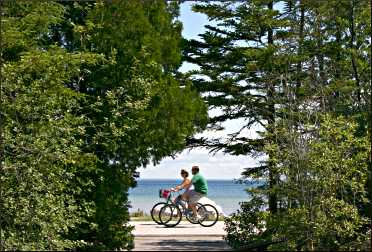
© Beth Gauper
In the straits between lakes Michigan and Huron, you can find more than one Mackinac Island.
The best-known first was advertised as "the Fairy Isle of Mackinac," and it's not quite rooted in reality. It has a tuxedo shop but no hardware store, a Victorian house called Brigadoon and a fan club that gathers every October in vintage clothing to revere the year 1912.
You get to that island in a horse-drawn surrey, driven by a liveryman in a top hat.
Then there's the day-tripper island, chockablock with ice-cream and fudge shops. You see that one from wagons on tours narrated by college students.
And there's the island we saw, on bicycles with backpacks. From the bemused look on the ferryman's face, we gathered that not many folks go to this famous island with their belongings on their backs.
Luckily for us, Mackinac is not a snobbish place.
Sure, we got shooed away from the Grand Hotel by a young woman who stood under an umbrella like Mary Poppins but looked much less friendly. But the locals are so outnumbered by the tourists — by a ratio of 600 to a million — that no one gets too hoity-toity.
It does cost more than $60 for two people to get there and back, or more than $100 with bikes, and that keeps out the riffraff.
But the ferry ride from St. Ignace or Mackinaw City has another function. By the time tourists arrive at the docks, they've had time to check out the big blufftop mansions and the sprawling 1887 Grand Hotel, and they're good and awed.
Most people know Mackinac Island for the very expensive Grand Hotel, where coats and ties are required at dinner, and for the spectacular Victorian manors built for the titans of the Gilded Age.
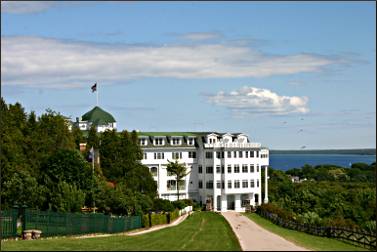
© Beth Gauper
But most of the island is state park, circled and crisscrossed by a skein of trails that can be used either for biking or hiking.
So regular folks own part of the island, too. That's why we brought our bikes, to see it up close and explore its nooks and crannies.
We arrived at the ferry docks on a Saturday in late June and walked our bikes to Main Street. It was early evening, and the smell of horse droppings had overwhelmed the tantalizing fudge aromas that usually assail unsuspecting tourists.
Private vehicles have been banned from the island since a car frightened several horses in 1900, injuring them and wrecking carriages.
Luggage is sent to hotels on horse-drawn wagons, but we just put on our backpacks and rode down the street to the Bogan Lane Inn, a modest B&B where a room with shared bath is about as cheap as rooms get on the island.
It was a beautiful evening. So after checking in, we kept riding on Lake Shore Road, also known as M-185, the only state highway in the nation that doesn't allow cars.
The eight-mile path circles the island, and our seat-top view was gorgeous — on one side, the calm waters of Lake Huron, and on the other, limestone outcroppings and white pebble beaches bathed in golden light.
Above us, we spotted Arch Rock, a famous ribbon of limestone that frames the lake when seen from the other side. We pedaled nearly alone until we got to British Landing on the other side of the island, where a few people were wading on the beach.
We would have had a burger at the 1927 Cannonball Inn, which looks a lot like a drive-in, but it had closed for the day. Instead, we had dinner downtown. As we were heading home, fireworks began exploding above the marina, marking the last days of Lilac Festival.
The next morning, I got up at 6:30 and climbed to the East Bluff on wooden steps at the end of Bogan Lane. Victorian manors lined the edge of the bluff, and I got to share their view.
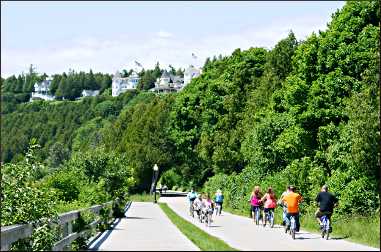
© Beth Gaupers
Over the white steeples and rooftops, I could see the Mackinac Bridge, its cables blending into the blue horizon. Outside the harbor, the 1895 Round Island Lighthouse and 1948 Round Island Passage Light glowed in the early sun. Beyond, an ore boat headed for Lake Michigan.
An elderly gent with a coffee cup in his hand pedaled past, bidding me good morning, and I wondered which of the Victorian mansions was his, and what it would be like to own one. It's a rare tourist who doesn't envy the owners of these genteel houses from another era.
The road led into the forest, and I walked past the entrance of Fort Mackinac to check out Skull Cave, a shallow nook named in 1763 by a British fur trader who was hiding from the Ojibwe during an "uprising" and supposedly found its floor littered with human bones.
Before Europeans arrived, the Ojibwe gathered at the island to fish. They named it Michilimackinac, land of the great turtle, for the rounded way the interior rises from the lake.
The well-located island became a hub of the fur trade, and in 1780, the British built a fort to protect their interests. After the War of 1812, they were forced to turn it over to the Americans.
After the fur trade waned, Mackinac became a fishing center, and in 1875, Congress made it the second national park, after Yellowstone.
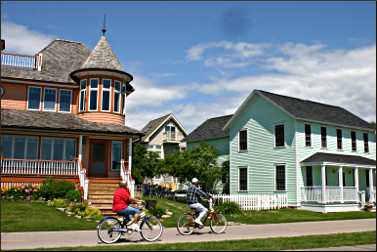
© Beth Gauper
But it didn't allocate funds to operate the park, so the superintendent raised money for roads and upkeep by selling leases for cottages.
At first, they were modest. But the Grand Hotel drew a more affluent crowd to the island after it was built in 1887, and private cottages became bigger and fancier.
Fort Mackinac's soldiers took care of tourists until 1894, when the fort was dismantled. No longer willing to pay the bills, the federal government then unloaded the island onto the state, and it became Michigan's first state park.
Now, Fort Mackinac is a living history site, with costumed interpreters re-creating life at the fort and five historic buildings downtown.
By 7:30 a.m., when I got back down to Main Street, the island was coming alive. I heard the clip-clops of the first horses, and at 8, the first ferryboat horn.
After breakfast, we headed out again on the lake path, this time stopping to walk on the Lake Shore Nature Trail, where bullfrogs rumbled like grouchy Chihuahuas. Wildflowers love this island as much as the tourists, and the trail was lined by buttercups, coreopsis and hawkweed.
At Scott's Shore Road, we left the lake and climbed up into forest, where we took whatever trail looked most promising. Some of the trails looked more like footpaths, which led to a dilemma: Bike or hike?
We got off our bikes to walk on the British Landing Nature Trail, where we caught a snake with its jaws clamped onto the rump of a toad. For 10 minutes, the four of us stared at each other, the frog croaking occasionally. But since the snake wasn't going to do any swallowing while we were there, we left it to its grisly business.
On the North Bicycle Trail, we found the Sugar Loaf, a spire of pocked puddingstone that's much more interesting than Skull Cave but isn't a big tourist draw because it's on a trail too narrow for the wagon tours to negotiate.
We also found steps leading to Fort Holmes, the ruins of a fortified outpost built by the British on the island's highest point in 1812. It has the island's best view, and this time we spotted three ore boats.
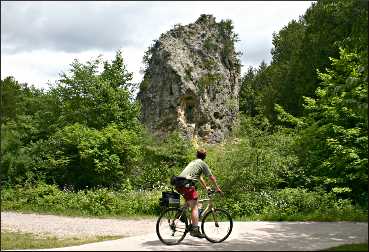
© Beth Gauper
We swooped all over the island — down to the Cannonball for a twist cone; past the Wawashkamo Golf Course, built on a 1814 battlefield; through the village-like Grand Hotel complex, with shops and restaurants; and past the West Bluff mansions, where we got off our bikes again to walk the short but intimate Pontiac Trail.
One of the most surprising places we found was Harrisonville, a neighborhood of newer middle-class homes. By then, we'd seen so many opulent Victorians that they seemed like the norm, and these homes seemed out of place.
They'll all expensive, though. Trish Martin, a former teacher who runs the 1850s Bogan Lane Inn, told us it's hideously expensive to build or renovate anything on the island.
"Everything costs twice as much and takes three times as long," she said. "If not, it costs three times as much and takes twice as long."
On our second morning, my husband and I rode downtown to use the wifi at Starbucks, but when I joined him, he was glum — it wasn't working. Then we noticed Marc's Double Oven Bakery across the street, also with wifi, so we went there.
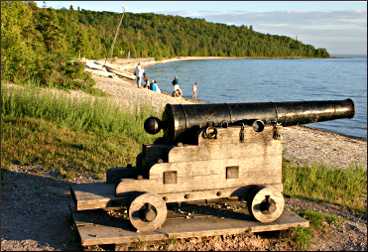
© Beth Gauper
Owner Marc Bobinsky, also a former teacher, turned out to have plenty of say about Starbucks, which had prompted a village ordinance against "formula" businesses that he didn't think would stick because so many of the fudge shops are part of regional chains.
We were glad to listen because his pastries and coffee were so good, and it was fun hearing about island politics. We thought he might have a similarly jaundiced view of the Grand Hotel, but there we were wrong.
"Yes, it's a holdover, and yes, it's a relic," Bobinsky said. "But it's the raison d'etre for the entire island."
When he was teaching at the island school, he said, he asked the hotel if he could bring his students to tour the place where many of their parents worked. Not only did the hotel agree but, for a few dollars included a meal where the children were treated as honored guests.
"It's a family-run business, and they're very good," he said. "They treat people well."
I doubt we'll ever be guests, but we're glad the Grand Hotel is there. Even if we didn't get to see the famous 660-foot-long front porch, visited by five presidents, we liked seeing it from the ferry and our bikes.
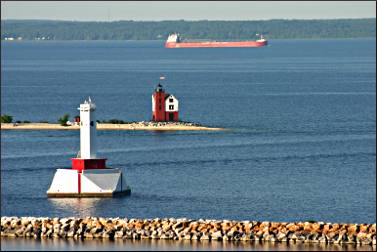
© Beth Gauper
The people who love the Grand, however, really love it. The 1980 time-travel fantasy "Somewhere in Time," starring Christopher Reeve and Jane Seymour, was filmed there, and it has a fan club that gathers at the hotel every October.
Whether you see Mackinac Island from a bike or the balcony of a fancy hotel, it really is pretty magical.
We left knowing that, while we'd seen a lot, we hadn't seen so much we didn't need to come back. I'll bet those trails are really pretty in fall.
Trip Tips: Mackinac Island in Michigan
Getting there: You can save a few bucks by buying ferry tickets online or showing an AAA card, and many lodgings give their guests coupons for discounts.
Shepler's Ferry and the Star Line run ferries to the island from St. Ignace on the Upper Peninsula and from Mackinaw City. You'll get a discount if you buy tickets online.
For more about Mackinaw City, see Destination: Mackinaw City.
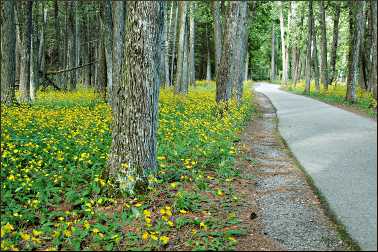
© Torsten Muller
When to go: Late May is best for wildflowers, and the island is glorious when the lilacs bloom in mid-June, though peak bloom is notoriously hard to predict.
Peak season is July and the first part of August. You'll save money if you can go in May, June or even the last week of August, and even more in the off-season.
Because it's surrounded by water, the island stays warm longer into the fall than the mainland, and prices go down. Many lodgings are closed from November through April.
2023 events: June 9-18, Lilac Festival, with a big final-day parade. July 4, stone-skipping contest and fireworks. Aug. 25-27, Fudge Festival. Sept. 4, Mackinac Bridge Walk.
Bicycling: There are lots of places to rent cruiser-style and mountain bikes, but they're not cheap.
If you want to zip downtown for a pastry in the morning or take a leisurely sunset ride around the island, bring your own bike. You'll want the extra gears to ride up the steep hills.
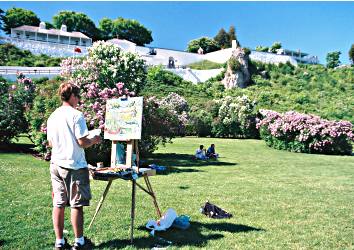
© Beth Gauper
Horseback-riding: Cindy's Riding Stable on Market Street provides horses for guided or unguided trail rides.
Kayaking: Great Turtle Kayak Tours offers guided paddle trips around the island.
Accommodations: Because of the expense of operating on an island, nothing is cheap. However, it's possible to visit on a budget.
If you like the bustle of downtown Mackinac Island and you're on a budget, try the Pontiac Lodge, on the west end of downtown, or the large, gabled Chippewa Hotel, which faces the harbor next to the state-park visitors center on the east end.
On the west end of Main Street, the Lilac Tree Suites and Spa and Main Street Inn and Suites are fancier, with large balconies. The turreted Lake View Hotel first was built in 1858.
The Hotel Iroquois faces the breakwall at the west end of downtown, next to a pebble beach. The Windermere Hotel is across the street.
Just beyond the east end of downtown, the large Bay View B&B is at the edge of the marina and includes the Coffee House Beanery.
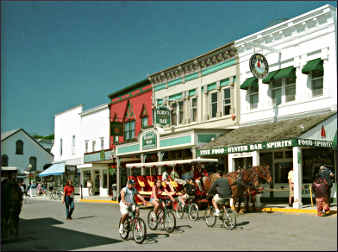
© Beth Gauper
The Harbour View Inn is in the east residential section.
Quiet Bogan Lane Inn, under the East Bluff, has four rooms, three with shared baths. Across the street, Pine Cottage is an old hotel with modestly priced rooms, some with shared bath. Both have pleasant porches and include a continental breakfast.
At the end of the east residential section, Mission Point Resort is a sprawling newer complex that faces a large open area and the lake.
The most luxurious place to stay is the Grand Hotel on the West Bluff, where standard rooms go for $350 and up per person, including breakfast and dinner, plus 19.5 percent service charge, plus 6 percent state tax on top of that, plus the 2 percent island assessment, plus $7.50 per person baggage handling, plus the taxi to get there.
However, it often offers specials early and late in the season. It opens in late April and closes in late October.
Dining: Restaurants are on the expensive side, because of transportation costs, and service can be uneven because so much of the help is seasonal.
The best budget meal is a 16-inch pizza from Doud's Market, which can feed three or four people.
Many people also like to lunch on the deck at the Tea Room of Fort Mackinac, which has a great view of the harbor.
If you want to get inside the Grand Hotel, the entry price can be applied to the cost of the lunch buffet.
Fort Mackinac: During the mid-June to late August high season, admission includes five other historic buildings staffed by interpreters. Admission is $15.50, $9.25 for children 5-12.
If you're also planning to go to Mackinaw City to visit Colonial Michilimackinac, Old Mackinac Point Lighthouse or Historic Mill Creek Discovery Park, which includes a zip line, it makes sense to buy a combination ticket.
Mackinac Island on a Circle Tour of Michigan: For more, see Circling Lake Michigan and Lake Michigan with kids.